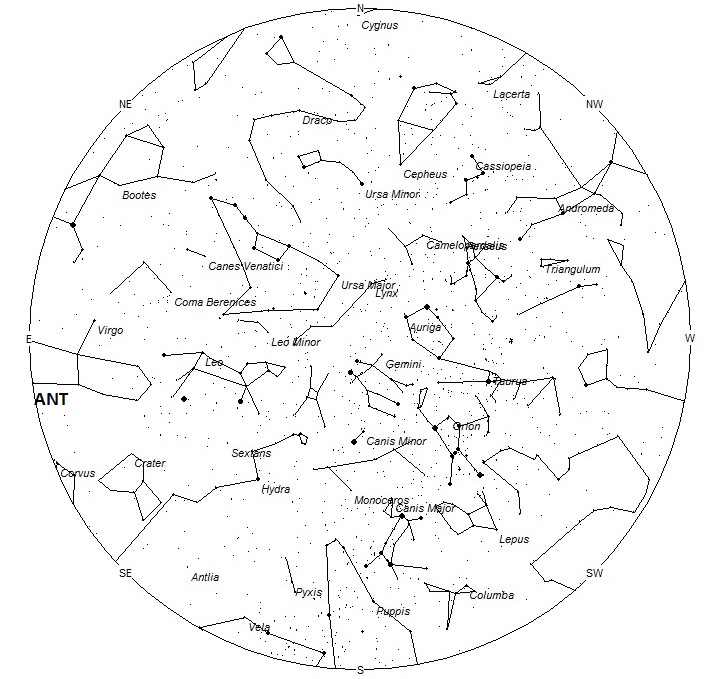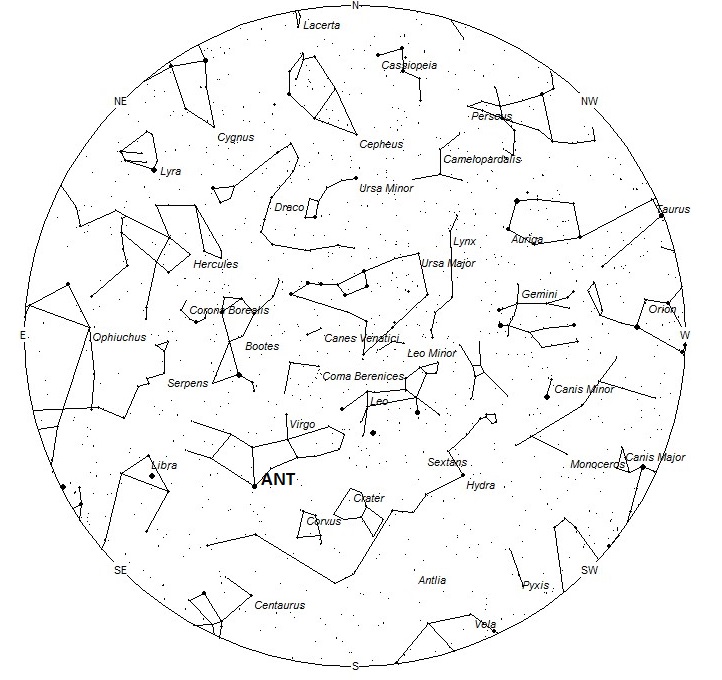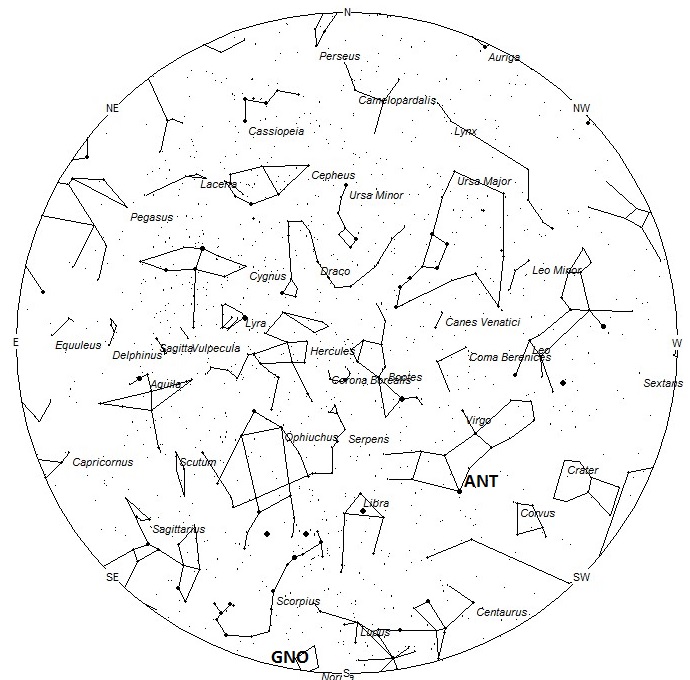
During this period the moon reaches its last quarter phase on Thursday March 31st. On that date the moon will be located 90 degrees west of the sun and will rise near 0200 daylight saving time as seen from many mid-northern latitude locations. This weekend the waning gibbous moon will rise during the late evening hours and will ruin meteor observing attempts during the remainder of the night. The estimated total hourly meteor rates for evening observers this week is near 3 for observers located in the northern hemisphere and 4 for observers located south of the equator. For morning observers the estimated total hourly rates should be near 5 as seen from mid-northern latitudes (45N) and 7 as seen from tropical southern locations (25S). Morning rates are reduced during this period due to moonlight. The actual rates will also depend on factors such as personal light and motion perception, local weather conditions, alertness and experience in watching meteor activity. Note that the hourly rates listed below are estimates as viewed from dark sky sites away from urban light sources. Observers viewing from urban areas will see less activity as only the brightest meteors will be visible from such locations.
The radiant (the area of the sky where meteors appear to shoot from) positions and rates listed below are exact for Saturday night/Sunday morning March 26/27. These positions do not change greatly day to day so the listed coordinates may be used during this entire period. Most star atlases (available at science stores and planetariums) will provide maps with grid lines of the celestial coordinates so that you may find out exactly where these positions are located in the sky. A planisphere or computer planetarium program is also useful in showing the sky at any time of night on any date of the year. Activity from each radiant is best seen when it is positioned highest in the sky, either due north or south along the meridian, depending on your latitude. It must be remembered that meteor activity is rarely seen at the radiant position. Rather they shoot outwards from the radiant so it is best to center your field of view so that the radiant lies at the edge and not the center. Viewing there will allow you to easily trace the path of each meteor back to the radiant (if it is a shower member) or in another direction if it is a sporadic. Meteor activity is not seen from radiants that are located below the horizon. The positions below are listed in a west to east manner in order of right ascension (celestial longitude). The positions listed first are located further west therefore are accessible earlier in the night while those listed further down the list rise later in the night.
These sources of meteoric activity are expected to be active this week.
The center of the large Anthelion (ANT) radiant is currently located at 13:16 (199) -08. This position lies in southern Virgo, 4 degrees south of the 1st magnitude star known as Spica (Alpha Virginis). Due to the large size of this radiant, Anthelion activity may also appear from the nearby constellations of Corvus, eastern Hydra, and Libra as well as Virgo. This radiant is best placed near 0200 local daylight saving time (LDT), when it lies on the meridian and is located highest in the sky. Rates at this time should be near 2 per hour no matter your location. With an entry velocity of 30 km/sec., the average Anthelion meteor would be of slow velocity.
The Gamma Normids (GNO) are usually listed as occurring earlier in the month with a peak on March 14th. Using video cameras located in Australia, Sirko Molau of the IMO has determined that this source is actually active from March 23-28, with a peak on the 24th. The radiant position currently lies at 16:40 (250) -49. This position is located in extreme western Ara, 3 degrees southeast of the faint star known as Epsilon Normae. This radiant is best placed during the last hour before dawn when it lies highest above the horizon in a dark sky. Rates, even at maximum, will most likely be less than 1 per hour no matter your location. With an entry velocity of 68 km/sec., the average meteor from this source would be of fast velocity.
As seen from the mid-northern hemisphere (45N) one would expect to see approximately 3 sporadic meteors per hour during the last hour before dawn as seen from rural observing sites. Evening rates would be near 2 per hour. As seen from the tropical southern latitudes (25S), morning rates would be near 5 per hour as seen from rural observing sites and 3 per hour during the evening hours. Locations between these two extremes would see activity between the listed figures. Morning rates are reduced during this period due to moonlight.
The list below offers the information from above in tabular form. Rates and positions are exact for Saturday night/Sunday morning except where noted in the shower descriptions.
| SHOWER | DATE OF MAXIMUM ACTIVITY | CELESTIAL POSITION | ENTRY VELOCITY | CULMINATION | HOURLY RATE | CLASS |
| RA (RA in Deg.) DEC | Km/Sec | Local Daylight Saving Time | North-South | |||
| Anthelions (ANT) | – | 12:48 (192) -06 | 30 | 02:00 | 2 – 2 | II |
| Gamma Normids (GNO) | Mar 24 | 16:40 (250) -49 | 68 | 06:00 | <1 – <1 | IV |
 American Meteor Society
American Meteor Society



Report from Lebanon, Virginia 24266, 2300 edt, March 29, 2016.
Several meteors in the southeast, south, southwest and west. Looking only in these directions. Total, less than ten. Bright meteors in a clear sky.
Very large meteorite, it was audible, passing from just behind Leo and disappearing in Bootes. It was green for a moment there, and it was at about 9:50 Central Time on the 31st of March. Viewed from Emporia Kansas by 2 members of the Planetarium crew.
Hi there from 29th March, 16′ Saw on route to Miami from Orlando a greeny / blue whopping star (not a star as they are minute in comparison thing, then fade into an orangey dust. then 2 miles down the highway a truck was burnt on its side facing the wrong way in our lane on the high way. Coincidence i know – but would like to know what it was we saw…. This is the only site after trawling the net for an hour so, but mostly are dead ends, with ramblings about other things they have seen but no real evidence of what it was I saw just that others had seen it to.
Thanks
Sally